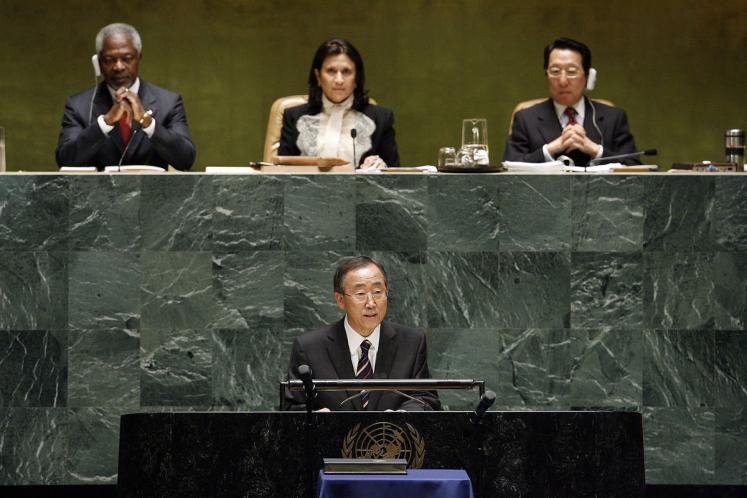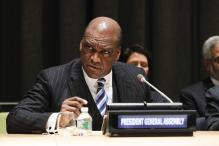Since the mid-1990s, the larger UN membership has become increasingly uncomfortable with the stranglehold that the five permanent members of the Security Council (P5) exert over the selection of the UN Secretary-General.
Even some longtime observers of the UN assume that any meaningful reforms of the selection process would require amendments to the UN Charter. But in reality, all the UN Charter has to say about the issue is in Article 97, simply stating that the Secretary-General “shall be appointed by the General Assembly upon the recommendation of the Security Council.”
Important details of the process were agreed upon in a 1946 resolution of the General Assembly (Resolution 11), which specified that Secretary-General appointments were to be for five years with the possibility of a second term; the Council was to proffer only a single candidate to the GA; and decisions in both the Council and the Assembly would be taken in private meetings by a secret ballot.
In reality, this has meant that the selection of Secretaries-General was mostly taken by the P5 in a process where vetoing each others’ preferred candidates has yielded mixed results, at times producing strong and respectable Secretaries-General and at others favoring lowest common denominator outcomes. Over the past decades, the General Assembly has without fail rubberstamped the Security Council’s choices.
This practice is now widely seen as outdated. There is no doubt the Secretary-General needs to have the confidence of the Council and its permanent members to be effective. At the same time, the Secretary-General is increasingly seen as the voice of the vulnerable, the guardian of global norms, and the standard-bearer of the world’s conscience, warranting a more inclusive and transparent process.
In 2006, when the last Secretary-General transition took place, a number of sensible proposals on reforming the selection process were tabled (most notably by the Canadian government) but failed to lead to actual changes, largely because of a combination of P5 opposition, a confrontational approach by the non-aligned movement, and insufficient engagement by the silent majority of Member States.
Nine years later, with yet another Secretary-General transition coming up, the discontent with the P5-dominated process has grown significantly, and reform proposals are being pushed by a coalition that includes the ACT Grouping (27 Member States who advocate for greater “Accountability, Coherence, and Transparency” of the Security Council), the Elders, and the “1 for 7 billion” civil society campaign representing over 100 NGOs.
Key reform proposals tabled by these groups include:
-
limiting the Secretary-General's service to a single, non-renewable term of seven years;
-
insisting that the Security Council recommends more than one candidate to the General Assembly;
-
having the General Assembly and the Security Council issue an official call for nominations;
-
ending the practice of regional rotation;
-
introducing a deadline for submitting candidatures;
-
having the Security Council and the General Assembly conduct briefings with candidates; and
-
formulating selection criteria.
Remarkably, on 11 September 2015, the General Assembly adopted a resolution in which a significant number of these recommendations were endorsed. Specifically, the Resolution:
-
requests that the Presidents of the General Assembly and the Security Council kick off the selection process by jointly inviting Member States to submit candidacies and to keep the membership informed of the list of candidates;
-
formulates selection criteria, including “highest standards of efficiency, competence and integrity”, as well as “proven leadership and managerial abilities, extensive experience in international relations and strong diplomatic, communication and multilingual skills”;
-
decides that the General Assembly would conduct “informal dialogues or meetings” with candidates running for the post, without making participation in such dialogues a precondition for being selected (this latter clause was inserted upon insistence by Russia and the US who wanted to keep a backdoor open for eleventh hour candidacies, which also explains the absence of any reference to application deadlines in the resolution);
-
seems to be moving away, ever so slightly, from the principle of “regional rotation” (which the GA had identified as a guiding principle of the selection process in 1997), referring instead to “geographical balance”. The resolution also places special emphasis on inviting women candidates.
These steps constitute meaningful progress in terms of introducing some transparency into the hitherto opaque process of selecting UN Secretaries-General.
Of course, not all the reform proposals pushed by ACT, the Elders, and others found entry into last week’s General Assembly resolution. In parts, this is good news. Indeed, asking the Council to recommend multiple Secretary-General candidates may be a bad idea. Having two or more candidates compete for a two-thirds majority of votes in the General Assembly is likely to be a highly divisive process, leading them to play to the gallery, and possibly undermining their legitimacy if they end up only having the support of parts of the membership. Also, as former Jordanian Permanent Representative Prince Zeid (and current High Commissioner for Human Rights) once pointed out, the General Assembly does not exactly have a proud track record when it comes to electing its own presidents.
Another reform proposal that fell by the wayside in the General Assembly negotiations is to introduce a single seven-year term for the Secretary-General. That is a shame, because this would be the single most important reform to strengthen the Secretary-General’s independence vis-à-vis the P5 – and this is exactly the reason the P5 fought this proposal tooth and nail. Greater independence would lessen the incentives of any newly elected Secretary-General to repay the P5 with senior UN posts for their support. Few things undermine the credibility of the UN Secretariat more than the fact that key UN departments are seen to be “owned” by different P5 governments.
Yet, given that the Secretary-General's term of office is governed by a General Assembly resolution rather than the Charter, it can also be overruled by a new General Assembly resolution. Indeed, Resolution 11 of 1946 specifically notes that the General Assembly and the Security Council “are free to modify the term of office of future Secretaries-General in the light of experience” and there are precedents for such modifications. The General Assembly should therefore be ready to challenge the P5 and appoint – through a resolution – whichever candidate the Council recommends, for a single term of seven years.
However, there is a need to add additional layers of quality control in the selection process before the point where the Security Council makes a recommendation. The issue is too important to be left to the P5 alone. Here the elected ten members of the Council have important potential leverage as any candidate needs the support of at least 9 Council members (including at least 4 elected members) to be selected. Indeed, as a research paper by Security Council Report noted, “many candidates have been eliminated precisely because they had little support from the elected members at the early stages of voting.” Prospective elected members sitting in the Council in 2016 would thus do well to coordinate among themselves early to counter-balance any P5 tendency towards lowest common denominator candidates.
Finally, non-Council members interested in a strong and independent Secretary-General should actively engage in the process and make their weight felt. They should use the opportunity offered by informal hearings to assess different candidates against the sensible criteria developed by the General Assembly and help stiffen the spines of their colleagues among the elected Council members to support the best possible candidate. The future of the UN will in no small degree depend on the outcome of this process.
Suggested citation: Sebastian von Einsiedel., "Further Steps Needed To Open Up Secretary-General Selection Process," UNU-CPR (blog), 2015-09-17, https://unu.edu/cpr/blog-post/further-steps-needed-open-secretary-general-selection-process.



